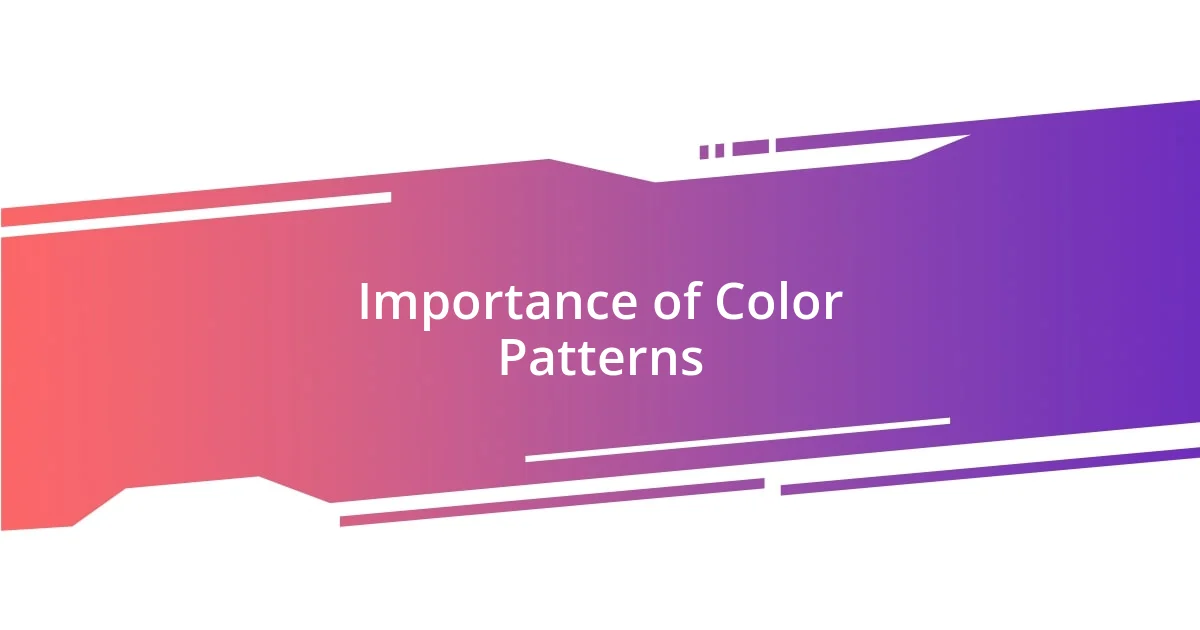Key takeaways:
- Color patterns in fish serve crucial functions such as communication, camouflage, and species identification, influencing both survival and social interactions.
- Different types of color patterns, including banded, spotted/mottled, and gradient, have unique aesthetic and functional roles in fish behavior and survival strategies.
- Selective breeding impacts color variations and mating success, showcasing the intricate relationship between genetics, beauty, and behavior in fish populations.

Understanding Color Patterns in Fish
Color patterns in fish serve various purposes—it’s fascinating how these patterns tell a story about each species. For instance, when I first observed the vibrant hues of a clownfish in a reef tank, I was struck by how its colors seemed to pulsate with the underwater light. Was it merely for beauty? I later learned that these patterns can signal readiness to mate, establish territory, or even warn predators.
I remember the thrill I felt watching a school of angelfish darting around their tank, their striking yellows and blues creating a mesmerizing dance. I couldn’t help but wonder: how do these colors affect their interactions? Research suggests that these bright colorations play a crucial role in social communication—almost like an underwater language. Each flash and flick creates a dialogue filled with meaning.
Moreover, I’ve come to appreciate how environmental factors contribute to these color patterns. For example, in murkier waters, fish tend to develop darker hues to blend in. This adaptability speaks volumes about survival instincts. Isn’t it amazing how fish can shift their appearance to navigate the complexities of their habitat? Their color patterns are not just for show; they’re essential tools for surviving in an ever-evolving world.

Importance of Color Patterns
Color patterns are crucial in the life of fish for several reasons. I often think about how many times I’ve marveled at the subtle shifts in a fish’s color. For instance, watching a male betta flare his fins, showcasing vivid blues and reds, made me realize that these colors can be linked to breeding status. They can signal to potential mates, making their presence known in vibrant displays that are often as beautiful as they are functional.
- Communication: Bright colors often convey messages like mating readiness or aggression.
- Camouflage: Patterns can help fish blend into their environment, evading predators.
- Species Identification: Unique color patterns assist in distinguishing between different species, especially in diverse habitats.
- Social Interactions: Color changes can indicate stress levels or territorial disputes.
I’ve experienced a moment observing a chameleon-like wrasse change colors, highlighting its mood. It’s astonishing to see how color can alter an entire interaction, showing just how significant these patterns are in their day-to-day existence. The deeply rooted importance of color patterns goes beyond beauty and dives straight into the essence of survival and communication in the aquatic world.

Types of Fish Color Patterns
When it comes to the types of color patterns in fish, I’ve noticed several distinctive groups emerge. For instance, some fish exhibit banded patterns that create striking horizontal or vertical lines, which not only enhance their aesthetic appeal but also serve as great camouflage. I recall visiting an aquarium and being mesmerized by the beauty of a tiger barb, with its bold stripes that seemed to dance under the aquarium lights. This visual not only captivated me but made me appreciate how such patterns can help fish blend seamlessly into their environments.
In contrast, spotted or mottled patterns provide another layer of complexity. These designs, reminiscent of a painter’s canvas, can either attract or deter the eye, depending on the surrounding environment. I vividly remember the first time I saw a leopard gecko pattern displayed on a fish. It was fascinating how the random spots created a sense of movement, making it difficult for predators to focus. Such adaptations are a true testament to nature’s artistry.
Lastly, the dynamic gradient patterns depict a smooth transition of colors, often observed in angelfish. These softer shifts create an elegant and ethereal effect. Watching these graceful fish glide by in my tank, I was filled with a sense of serenity; their shifting hues seemed to mirror the feelings I experienced while meditating. It strikes me as extraordinary how much emotion and communication can be conveyed through these beautiful patterns.
| Color Pattern Type | Description |
|---|---|
| Banded | Horizontal or vertical lines, often for camouflage. |
| Spotted/Mottled | Random spots that can confuse predators. |
| Gradient | Smooth color transitions that convey elegance. |

Factors Influencing Fish Coloration
Coloration in fish is influenced by a myriad of factors, each contributing uniquely to the vibrant displays we often admire. For instance, one of the most mesmerizing experiences I’ve had involved observing a school of clownfish. Their bright orange and white stripes aren’t just eye candy; they help them camouflage among the anemones, offering protection from predators. Isn’t it fascinating how their striking appearance plays a crucial role in their survival?
Environmental factors also have a significant impact on fish coloration. I recall taking a trip to a local coral reef and noticing how the same species of fish could look entirely different based on their surroundings. The colors seemed to shift and adapt, almost like they were changing outfits to blend with the corals and rocks. This ability to alter their appearance is not just about aesthetic appeal but is a vital adaptation for evading predators and hunting prey.
Then there’s the role of genetics in coloration, which is something I find deeply intriguing. I remember discussing this topic with a hobbyist friend who bred bettas. He explained how selective breeding can enhance vibrant colors and unique patterns. It made me appreciate the artistry behind fish breeding and how specific traits are passed down, creating variations that can evoke emotion and admiration. So, have you ever thought about how much history and intention goes into the colors of the fish we see today?

How Color Patterns Affect Behavior
Color patterns in fish are more than just decorative; they fundamentally influence behavior. For instance, I often observe how brightly colored fish, like the betta, display their vivid hues when they feel threatened. This sudden burst of color isn’t just for show; it serves as a warning to others, signaling both aggression and a call for space. Isn’t it remarkable how communication can manifest through such vibrant displays?
Moreover, I’ve noticed that color patterns can affect mating rituals significantly. In my own experience breeding guppies, the males with the most striking patterns often attracted more females. Their elaborate displays became almost theatrical, highlighting the intricate dance of evolution where survival of the fittest meets the allure of beauty. Have you ever watched a courting fish and found yourself captivated by the sheer effort they put into flaunting their colors?
On the flip side, I’ve seen how some fish use their colors strategically for safety. Take, for example, a school of damselfish. When threatened, they often group tightly, their uniform colors creating a mesmerizing visual that can confuse predators. This camouflage strategy always blows my mind—how an entire school can seem to vanish in plain sight! Such behaviors remind me of the incredible tactical thinking present in the animal kingdom.

Breeding and Color Patterns
When it comes to breeding and color patterns, I find it endlessly fascinating how fish enthusiasts often selectively breed for specific hues and designs. I remember a visit to a local aquarium where they showcased a betta breeding competition. Each tank displayed brilliant variations—from electric blues to fiery reds—crafted through meticulous selection. It made me wonder, how much personal effort and understanding goes into shaping these aquatic beauties?
In my experience, I’ve noticed that certain color combinations can also influence mating success. While breeding my own platies, I was struck by how the males with bright spots attracted the females’ attention immediately. It was as if these colors acted like magnets, drawing admirers in—an evolutionary strategy that simply can’t be overstated. Don’t you find it impressive how nature weaves such compelling narratives into the lives of these creatures?
Moreover, the effects of breeding on color are not just about attraction; they can also lead to unexpected quirks in temperament. I once bred a batch of guppies, and the offspring exhibited an unexpected mix of the parents’ colors along with shifts in behavior. Some were surprisingly bold, while others were skittish despite sharing bright colors. This experience reminded me how breeding isn’t just a science—it’s an art where unpredictability often adds to the charm. Have you considered how the interplay of genetics, beauty, and behavior creates a complex tapestry in the fish world?













